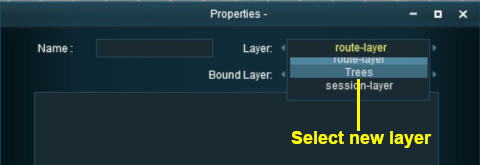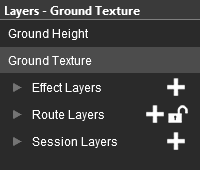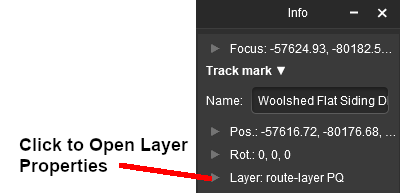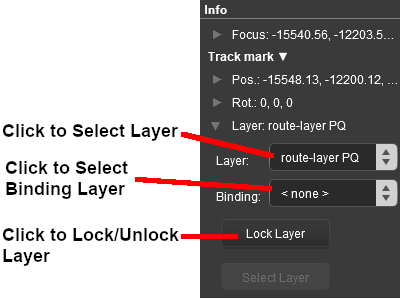How to Use Layers
(→The Bound Layer) |
m |
||
| Line 12: | Line 12: | ||
<tr valign="top"> | <tr valign="top"> | ||
<td width=10>[[file:DotPoint.JPG|10px|link=]]</td> | <td width=10>[[file:DotPoint.JPG|10px|link=]]</td> | ||
| − | <td>'''Layers are a ''Surveyor'' tool that allows you to better manage the objects that are placed in your Trainz World.'''<td> | + | <td>'''Layers are a ''Surveyor'' tool that allows you to better manage the objects that are placed in your Trainz World.'''</td> |
</tr> | </tr> | ||
<tr valign="top"> | <tr valign="top"> | ||
<td width=10>[[file:DotPoint.JPG|10px|link=]]</td> | <td width=10>[[file:DotPoint.JPG|10px|link=]]</td> | ||
| − | <td>'''Layers are a ''Driver'' tool that allows you to change what the players see as they drive around your Trainz World.'''<td> | + | <td>'''Layers are a ''Driver'' tool that allows you to change what the players see as they drive around your Trainz World.'''</td> |
</tr> | </tr> | ||
</table> | </table> | ||
| Line 89: | Line 89: | ||
<table> <!-- BEGIN Nav Buttons Table --> | <table> <!-- BEGIN Nav Buttons Table --> | ||
<tr valign="top"> | <tr valign="top"> | ||
| − | <td width=729><span id="stepWhat"></span>& | + | <td width=729><span id="stepWhat"></span> </td> |
<td width=46>[[file:BackToTop.png|link=#top|alt=Top|Top]]</td> | <td width=46>[[file:BackToTop.png|link=#top|alt=Top|Top]]</td> | ||
| − | <td width=75>& | + | <td width=75> </td> |
<td width=75>[[file:NextDown.png|link=#stepToolS20|alt=Next Down|Next Down]]</td> | <td width=75>[[file:NextDown.png|link=#stepToolS20|alt=Next Down|Next Down]]</td> | ||
<td width=75>[[file:BackToBottom.png|link=#bottom|alt=Bottom|Bottom]]</td> | <td width=75>[[file:BackToBottom.png|link=#bottom|alt=Bottom|Bottom]]</td> | ||
| Line 125: | Line 125: | ||
<br> | <br> | ||
| − | =''' | + | ='''The Layers Tool in Surveyor Classic (S10)'''= |
<table> | <table> | ||
<tr valign="top"> | <tr valign="top"> | ||
<td>[[file:SurveyorToolMenuLayers.JPG|150px]]</td> | <td>[[file:SurveyorToolMenuLayers.JPG|150px]]</td> | ||
| − | <td><br><br><br><br><br><br><br><br><br><br><br><br><br>[[file:RightArrowRed.JPG|link=]] | + | <td><br><br><br><br><br><br><br><br><br><br><br><br><br>[[file:RightArrowRed.JPG|link=]]</td> |
| − | <td>Click the '''Layers Tool''' (or press <span style="font-weight: 700; font-size: | + | <td><span style="font-weight: 700; font-size: 15px; background-color: lightcyan;">Left Click</span> the '''Layers Tool''' (or press <span style="font-weight: 700; font-size: 15px; color: white; background-color: black;"> F6 </span>) to open up its properties.<br> |
[[file:LayersTools.JPG|480px]]</td> | [[file:LayersTools.JPG|480px]]</td> | ||
<td> | <td> | ||
| Line 159: | Line 159: | ||
<br> | <br> | ||
| − | ==''' | + | =='''Loading a Route and Loading a Session (S10)'''== |
<table cellpadding=4 bgcolor=#c1e7e7 width="730"> <!-- BEGIN top level --> | <table cellpadding=4 bgcolor=#c1e7e7 width="730"> <!-- BEGIN top level --> | ||
| Line 167: | Line 167: | ||
<tr valign="top"> | <tr valign="top"> | ||
<td width=10>[[file:DotPoint.JPG|10px|link=]]</td> | <td width=10>[[file:DotPoint.JPG|10px|link=]]</td> | ||
| − | <td>'''Route Layers are saved with the Route. Session Layers are saved with the Session.<td> | + | <td>'''Route Layers are saved with the Route. Session Layers are saved with the Session.</td> |
</tr> | </tr> | ||
<tr valign="top"> | <tr valign="top"> | ||
| Line 212: | Line 212: | ||
<tr valign="top"> | <tr valign="top"> | ||
<td>[[file:PencilTips.PNG|link=]]</td> | <td>[[file:PencilTips.PNG|link=]]</td> | ||
| − | <td>If you load a '''Session''' and do not want to edit any of the '''Route layers''' then | + | <td>If you load a '''Session''' and do not want to edit any of the '''Route layers''' then <span style="font-weight: 700; font-size: 15px; background-color: lightcyan;">Left Click</span> the '''Lock Route Layers''' icon on the '''Layers Tool''' |
<table> <!-- BEGIN 3rd level --> | <table> <!-- BEGIN 3rd level --> | ||
<tr> | <tr> | ||
<td>[[file:LayersToolButtonsLOCKALL.JPG|link=]]</td> | <td>[[file:LayersToolButtonsLOCKALL.JPG|link=]]</td> | ||
| − | <td>Click the '''Lock Button''' | + | <td><span style="font-weight: 700; font-size: 15px; background-color: lightcyan;">Left Click</span> the '''Lock Button''' |
</td> | </td> | ||
</tr> | </tr> | ||
| Line 253: | Line 253: | ||
</table> | </table> | ||
| − | ==''' | + | =='''Creating a New Route (S10)'''== |
<table> | <table> | ||
| Line 280: | Line 280: | ||
<tr valign="top"> | <tr valign="top"> | ||
<td>[[file:PencilTips.PNG|link=]]</td> | <td>[[file:PencilTips.PNG|link=]]</td> | ||
| − | <td>'''A layer can be renamed at anytime by | + | <td>'''A layer can be renamed at anytime by a''' <span style="font-weight: 700; font-size: 15px; background-color: lightcyan;">Double Left Click</span> '''on its name and entering a new name''' |
</td> | </td> | ||
</tr> | </tr> | ||
| Line 297: | Line 297: | ||
</table> | </table> | ||
| − | ==''' | + | =='''The "Active Layer" (S10)'''== |
<table cellpadding=4 bgcolor=#c1e7e7> | <table cellpadding=4 bgcolor=#c1e7e7> | ||
| Line 316: | Line 316: | ||
</tr> | </tr> | ||
</table> | </table> | ||
| − | In the image above, the '''route-layer''' is the '''Active Layer'''. You can change the '''Active Layer''' at any time by | + | In the image above, the '''route-layer''' is the '''Active Layer'''. You can change the '''Active Layer''' at any time by a <span style="font-weight: 700; font-size: 15px; background-color: lightcyan;">Left Click</span> on the name of another layer. |
<br> | <br> | ||
| Line 340: | Line 340: | ||
</table> | </table> | ||
</td> | </td> | ||
| − | <td width=12>& | + | <td width=12> </td> |
<td width=484> | <td width=484> | ||
<table bgcolor="red" width=464> | <table bgcolor="red" width=464> | ||
| Line 360: | Line 360: | ||
</table> | </table> | ||
<br> | <br> | ||
| − | ==''' | + | =='''Adding a New Layer (S10)'''== |
<table> | <table> | ||
<tr> | <tr> | ||
<td>[[file:LayersToolButtonsADD.JPG|link=]]</td> | <td>[[file:LayersToolButtonsADD.JPG|link=]]</td> | ||
| − | <td>Click the '''Add Button'''</td> | + | <td><span style="font-weight: 700; font-size: 15px; background-color: lightcyan;">Left Click</span> the '''Add Button'''</td> |
</tr> | </tr> | ||
</table> | </table> | ||
| Line 385: | Line 385: | ||
#Enter a name for the new layer | #Enter a name for the new layer | ||
#Select the layer group, '''Route''' or '''Session''', where it will be placed | #Select the layer group, '''Route''' or '''Session''', where it will be placed | ||
| − | #Click the [[file:Tick.PNG|link=]] icon</td> | + | #<span style="font-weight: 700; font-size: 15px; background-color: lightcyan;">Left Click</span> on the [[file:Tick.PNG|link=]] icon</td> |
</tr> | </tr> | ||
<tr> | <tr> | ||
| Line 408: | Line 408: | ||
</table> | </table> | ||
| − | ==''' | + | =='''Deleting a Layer (S10)'''== |
<table bgcolor="red" width=300> | <table bgcolor="red" width=300> | ||
| Line 428: | Line 428: | ||
<tr> | <tr> | ||
<td>[[file:LayersToolButtonsDELETE.JPG|link=]]</td> | <td>[[file:LayersToolButtonsDELETE.JPG|link=]]</td> | ||
| − | <td>Select the layer to be deleted and | + | <td>Select the layer to be deleted and <span style="font-weight: 700; font-size: 15px; background-color: lightcyan;">Left Click</span> on the '''Delete Button'''. <span style="background-color: yellow; font-weight: 700;"> If you don't select a layer to delete then Trainz will select the current Active Layer. </span></td> |
</tr> | </tr> | ||
</table> | </table> | ||
| Line 443: | Line 443: | ||
<td>[[file:Stop.PNG|link=]]</td> | <td>[[file:Stop.PNG|link=]]</td> | ||
<td>In '''TRS19''' and later '''Trainz''' versions there will be a delay when deleting a layer. The delay will be indicated by a progress bar but can take several minutes on very large routes.<br> | <td>In '''TRS19''' and later '''Trainz''' versions there will be a delay when deleting a layer. The delay will be indicated by a progress bar but can take several minutes on very large routes.<br> | ||
| − | <span style="color: white; background-color: red; font-weight: 700;">& | + | <span style="color: white; background-color: red; font-weight: 700;"> Resist any urge to <span style="color: white;">Left Click</span> on the <span style="color: white; background-color: black; font-weight: 700; font-size: 15px;"> Cancel </span> button </span><br> |
This delay will occur '''every time''' a layer is deleted.</td> | This delay will occur '''every time''' a layer is deleted.</td> | ||
</tr> | </tr> | ||
| Line 470: | Line 470: | ||
<td>[[file:Choices.PNG|link=]]</td> | <td>[[file:Choices.PNG|link=]]</td> | ||
<td><span style="font-size: 17px;">'''Choices:'''</span><br> | <td><span style="font-size: 17px;">'''Choices:'''</span><br> | ||
| − | *Click | + | *<span style="font-weight: 700; font-size: 15px; background-color: lightcyan;">Left Click</span> <span style="color: white; background-color: black; font-weight: 700; font-size: 15px;"> Yes </span> to delete the layer |
| − | *Click | + | *<span style="font-weight: 700; font-size: 15px; background-color: lightcyan;">Left Click</span> <span style="color: white; background-color: black; font-weight: 700; font-size: 15px;"> No </span> to cancel the delete operation</td> |
</tr> | </tr> | ||
<tr> | <tr> | ||
| Line 482: | Line 482: | ||
</table> | </table> | ||
| − | If the layer being deleted is NOT empty, then the following dialogue window will appear:- | + | If the layer being deleted is '''NOT''' empty, then the following dialogue window will appear:- |
<table> | <table> | ||
| Line 496: | Line 496: | ||
<td>[[file:Choices.PNG|link=]]</td> | <td>[[file:Choices.PNG|link=]]</td> | ||
<td><span style="font-size: 17px;">'''Choices:'''</span><br> | <td><span style="font-size: 17px;">'''Choices:'''</span><br> | ||
| − | *Click | + | *<span style="font-weight: 700; font-size: 15px; background-color: lightcyan;">Left Click</span> <span style="color: white; background-color: black; font-weight: 700; font-size: 15px;"> Nerge </span> to merge this layer and its contents into another layer. See '''Merging Layers''' below for more information |
| − | *Click | + | *<span style="font-weight: 700; font-size: 15px; background-color: lightcyan;">Left Click</span> <span style="color: white; background-color: black; font-weight: 700; font-size: 15px;"> Delete </span> to delete the layer and its contents |
| − | *Click | + | *<span style="font-weight: 700; font-size: 15px; background-color: lightcyan;">Left Click</span> <span style="color: white; background-color: black; font-weight: 700; font-size: 15px;"> Cancel </span> to cancel the operation</td> |
</tr> | </tr> | ||
</table> | </table> | ||
| + | </td> | ||
</tr> | </tr> | ||
<tr> | <tr> | ||
| Line 509: | Line 510: | ||
</table> | </table> | ||
| − | ==''' | + | =='''Merging Layers (S10)'''== |
<table bgcolor="red" width=300> | <table bgcolor="red" width=300> | ||
| Line 529: | Line 530: | ||
<tr> | <tr> | ||
<td>[[file:LayersToolButtonsMERGE.JPG|link=]]</td> | <td>[[file:LayersToolButtonsMERGE.JPG|link=]]</td> | ||
| − | <td>Select the layer to be merged into another layer and | + | <td>Select the layer to be merged into another layer and <span style="font-weight: 700; font-size: 15px; background-color: lightcyan;">Left Click</span> the <span style="color: white; background-color: black; font-weight: 700; font-size: 15px;"> Merge </span> button. <span style="background-color: yellow; font-weight: 700;"> If you don't select a layer to merge then Trainz will select the current Active Layer. </span></td> |
</tr> | </tr> | ||
</table> | </table> | ||
| Line 553: | Line 554: | ||
<td>[[file:Stop.PNG|link=]]</td> | <td>[[file:Stop.PNG|link=]]</td> | ||
<td>In '''TRS19''' and later '''Trainz''' versions there will be a delay when merging a layer. The delay will be indicated by a progress bar but can take several minutes on very large routes.<br> | <td>In '''TRS19''' and later '''Trainz''' versions there will be a delay when merging a layer. The delay will be indicated by a progress bar but can take several minutes on very large routes.<br> | ||
| − | <span style="color: white; background-color: red; font-weight: 700;">& | + | <span style="color: white; background-color: red; font-weight: 700;"> Resist any urge to <span style="color: white;">Left Click</span> on the <span style="color: white; background-color: black; font-weight: 700; font-size: 15px;"> Cancel </span> button </span><br> |
This delay will occur '''every time''' a layer is merged. | This delay will occur '''every time''' a layer is merged. | ||
</td> | </td> | ||
| Line 578: | Line 579: | ||
<td><span style="font-size: 17px;">'''Steps:'''</span><br> | <td><span style="font-size: 17px;">'''Steps:'''</span><br> | ||
#Select the '''destination layer''' for the merge | #Select the '''destination layer''' for the merge | ||
| − | #Click the [[file:Tick.PNG|link=]] icon | + | #<span style="font-weight: 700; font-size: 15px; background-color: lightcyan;">Left Click</span> on the [[file:Tick.PNG|link=]] icon |
The '''Merge into:''' list shows all the available layers with no distinction between Route Layers and Session Layers</td> | The '''Merge into:''' list shows all the available layers with no distinction between Route Layers and Session Layers</td> | ||
</tr> | </tr> | ||
| Line 590: | Line 591: | ||
</table> | </table> | ||
| − | ==''' | + | =='''Locking Layers (S10)'''== |
<table bgcolor=#000000> | <table bgcolor=#000000> | ||
| Line 613: | Line 614: | ||
</table> | </table> | ||
<br> | <br> | ||
| − | === | + | ===Locking Individual Layers (S10)=== |
| − | '''To LOCK an individual layer, | + | '''To LOCK an individual layer,''' <span style="font-weight: 700; font-size: 15px; background-color: lightcyan;">Left Click</span> '''on the [[image:LayerUnLocked_S20.png|link=]] Open Padlock icon next to its name.''' The layer being locked does not have to be the current '''Active Layer'''. |
<table cellpadding=4 bgcolor=#c1e7e7> | <table cellpadding=4 bgcolor=#c1e7e7> | ||
<tr valign="top"> | <tr valign="top"> | ||
| Line 628: | Line 629: | ||
<td>[[file:LayersRouteTreesActiveLocked.JPG|link=]]</td> | <td>[[file:LayersRouteTreesActiveLocked.JPG|link=]]</td> | ||
<td><br> | <td><br> | ||
| − | *The first image on the left shows two Route Layers, both UNLOCKED with their Padlock icons '''Open'''. One layer, "Trees", is highlighted showing that it is the currently active layer. | + | *The first image on the left shows two Route Layers, both '''UNLOCKED''' with their Padlock icons '''Open'''. One layer, "Trees", is highlighted showing that it is the currently active layer. |
*The second image on the left shows the same two layers after the "Trees" layer has been LOCKED. | *The second image on the left shows the same two layers after the "Trees" layer has been LOCKED. | ||
| − | *A locked layer can be UNLOCKED by | + | *A locked layer can be '''UNLOCKED''' by a <span style="font-weight: 700; font-size: 15px; background-color: lightcyan;">Left Click</span> on its [[image:LayerLocked_S20.png|link=]] '''Closed Padlock''' icon.<br><br> |
</td> | </td> | ||
</tr> | </tr> | ||
| Line 638: | Line 639: | ||
<tr valign="top"> | <tr valign="top"> | ||
<td>[[file:LayersRouteTreesActiveLockedError.JPG|link=]]<br> | <td>[[file:LayersRouteTreesActiveLockedError.JPG|link=]]<br> | ||
| − | *Click the [[file:Tick.PNG|link=]] icon to UNLOCK the layer</td> | + | *<span style="font-weight: 700; font-size: 15px; background-color: lightcyan;">Left Click</span> on the [[file:Tick.PNG|link=]] icon to UNLOCK the layer</td> |
</tr> | </tr> | ||
</table> | </table> | ||
| − | === | + | ===Locking ALL Route Layers (S10)=== |
<table> | <table> | ||
<tr> | <tr> | ||
<td>[[file:LayersToolButtonsLOCKALL.JPG|link=]]</td> | <td>[[file:LayersToolButtonsLOCKALL.JPG|link=]]</td> | ||
| − | <td>Click the '''Lock Button'''</td> | + | <td><span style="font-weight: 700; font-size: 15px; background-color: lightcyan;">Left Click</span> on the '''Lock Button'''</td> |
</tr> | </tr> | ||
</table> | </table> | ||
| Line 653: | Line 654: | ||
This will LOCK ALL the layers in the Route Layers Group. The Session Layers Group will not be affected. | This will LOCK ALL the layers in the Route Layers Group. The Session Layers Group will not be affected. | ||
| − | The Route Layers Group can be UNLOCKED by | + | The Route Layers Group can be UNLOCKED by a <span style="font-weight: 700; font-size: 15px; background-color: lightcyan;">Left Click</span> on the '''Lock Button''' again. |
| − | ==''' | + | =='''Moving a Layer (S10)'''== |
<table cellpadding=4 bgcolor=#c1e7e7> | <table cellpadding=4 bgcolor=#c1e7e7> | ||
| Line 681: | Line 682: | ||
<td> | <td> | ||
In '''TRS19''' and later '''Trainz''' versions there will be a delay when moving a layer. The delay will be indicated by a progress bar but can take several minutes on very large routes<br> | In '''TRS19''' and later '''Trainz''' versions there will be a delay when moving a layer. The delay will be indicated by a progress bar but can take several minutes on very large routes<br> | ||
| − | <span style="color: white; background-color: red; font-weight: 700;">& | + | <span style="color: white; background-color: red; font-weight: 700;"> Resist any urge to <span style="color: white;">Left Click</span> on the <span style="color: white; background-color: black; font-weight: 700; font-size: 15px;"> Cancel </span> button </span><br> |
This delay will occur '''every time''' a layer is moved. | This delay will occur '''every time''' a layer is moved. | ||
</td> | </td> | ||
| Line 731: | Line 732: | ||
</table> | </table> | ||
| − | ==''' | + | =='''Hiding Layers (S10)'''== |
| − | To hide or show a layer | + | To hide or show a layer <span style="font-weight: 700; font-size: 15px; background-color: lightcyan;">Left Click</span> the '''Eye Icon''' next to its name. |
<table width=1000> | <table width=1000> | ||
| Line 740: | Line 741: | ||
<td> | <td> | ||
*In the image shown left the two trees are in different Route Layers | *In the image shown left the two trees are in different Route Layers | ||
| − | *All the layers have their '''Eye | + | *All the layers have their [[image:LayerEyeOpen_S20.png|link=]] '''Eye''' icons open (set to '''Show''') |
</td> | </td> | ||
</tr> | </tr> | ||
| Line 746: | Line 747: | ||
<td>[[file:LayersHideTree.JPG|link=]]</td> | <td>[[file:LayersHideTree.JPG|link=]]</td> | ||
<td> | <td> | ||
| − | *In the image shown left the '''Trees''' layer has its '''Eye | + | *In the image shown left the '''Trees''' layer has its [[image:LayerEyeClosed_S20.png|link=]] '''Eye''' icon closed (set to '''Hide''')<br><br> |
<table cellpadding=4 bgcolor=#c1e7e7> | <table cellpadding=4 bgcolor=#c1e7e7> | ||
<tr valign="top"> | <tr valign="top"> | ||
| Line 754: | Line 755: | ||
<tr valign="top"> | <tr valign="top"> | ||
<td width=10>[[file:DotPoint.JPG|10px|link=]]</td> | <td width=10>[[file:DotPoint.JPG|10px|link=]]</td> | ||
| − | <td>'''Layers that are hidden when saved in ''Surveyor'' will also be hidden when loaded in ''Driver''.'''<td> | + | <td>'''Layers that are hidden when saved in ''Surveyor'' will also be hidden when loaded in ''Driver''.'''</td> |
</tr> | </tr> | ||
</table> | </table> | ||
| Line 761: | Line 762: | ||
</table> | </table> | ||
| − | ==''' | + | =='''Adding Objects To Layers (S10)'''== |
When an object (such as a scenery item, consist, track or track object) is added to the layout it is automatically placed in the currently '''Active Layer'''. Unfortunately, '''Surveyor Classic (S10)''' does not indicate which layer is the '''Active Layer''' unless you open the Layers Tool to look. This can lead to objects being placed into the wrong layers and while these objects can later be moved to another layer (see the section [[file:PageLink.PNG|link=]] '''[[#Moving Objects To Other Layers|Moving Objects To Other Layers]]''' below) it would be better to correctly set the '''Active Layer''' first. | When an object (such as a scenery item, consist, track or track object) is added to the layout it is automatically placed in the currently '''Active Layer'''. Unfortunately, '''Surveyor Classic (S10)''' does not indicate which layer is the '''Active Layer''' unless you open the Layers Tool to look. This can lead to objects being placed into the wrong layers and while these objects can later be moved to another layer (see the section [[file:PageLink.PNG|link=]] '''[[#Moving Objects To Other Layers|Moving Objects To Other Layers]]''' below) it would be better to correctly set the '''Active Layer''' first. | ||
| Line 790: | Line 791: | ||
<tr valign="top"> | <tr valign="top"> | ||
<td>[[file:LayersRouteTreesActiveLockedError.JPG|link=]]<br> | <td>[[file:LayersRouteTreesActiveLockedError.JPG|link=]]<br> | ||
| − | *Click the [[file:Tick.PNG|link=]] icon to '''UNLOCK the layer'''.</td> | + | *<span style="font-weight: 700; font-size: 15px; background-color: lightcyan;">Left Click</span> on the [[file:Tick.PNG|link=]] icon to '''UNLOCK the layer'''.</td> |
</tr> | </tr> | ||
</table> | </table> | ||
| Line 834: | Line 835: | ||
<tr valign="top"> | <tr valign="top"> | ||
<td width=10>[[file:DotPoint.JPG|10px|link=]]</td> | <td width=10>[[file:DotPoint.JPG|10px|link=]]</td> | ||
| − | <td>When you enter or edit the name of a route layer scenery object, such as a station name board, that change will be treated as a change to the '''Session''' but the new or edited name will still be saved as a property of the scenery object in a '''Route''' layer. When you save, you will be given the option of saving the '''Session''' as well as the '''Route'''. You can ignore the offer to save the '''Session''' if you have not edited any objects in a '''Session Layer''', the '''Session Layers''' themselves (e.g. moved, merged, deleted or renamed) or other '''Session''' properties (e.g. commodity levels or loads). <span style="background-color: yellow; font-weight: 700;">& | + | <td>When you enter or edit the name of a route layer scenery object, such as a station name board, that change will be treated as a change to the '''Session''' but the new or edited name will still be saved as a property of the scenery object in a '''Route''' layer. When you save, you will be given the option of saving the '''Session''' as well as the '''Route'''. You can ignore the offer to save the '''Session''' if you have not edited any objects in a '''Session Layer''', the '''Session Layers''' themselves (e.g. moved, merged, deleted or renamed) or other '''Session''' properties (e.g. commodity levels or loads). <span style="background-color: yellow; font-weight: 700;"> If uncertain, always save the Session </span> |
</td> | </td> | ||
</tr> | </tr> | ||
| Line 848: | Line 849: | ||
<br> | <br> | ||
| − | ==''' | + | =='''Deleting Objects From Layers (S10)'''== |
<table bgcolor=#000000 width=900> | <table bgcolor=#000000 width=900> | ||
| Line 892: | Line 893: | ||
<br> | <br> | ||
| − | ==''' | + | =='''Moving Objects To Other Layers (S10)'''== |
<table width=1000> | <table width=1000> | ||
| Line 906: | Line 907: | ||
To move individual objects from one layer to another:- | To move individual objects from one layer to another:- | ||
#Open the '''Properties''' window ('''?''' button in the '''Object Tools''') of the object to be moved | #Open the '''Properties''' window ('''?''' button in the '''Object Tools''') of the object to be moved | ||
| − | #Click the '''Layer''' or one of the '''scroll buttons''' | + | #<span style="font-weight: 700; font-size: 15px; background-color: lightcyan;">Left Click</span> on the '''Layer''' or one of the '''scroll buttons''' |
#Select the new layer | #Select the new layer | ||
| − | #Click the [[file:Tick.PNG|link=]] icon | + | #<span style="font-weight: 700; font-size: 15px; background-color: lightcyan;">Left Click</span> on the [[file:Tick.PNG|link=]] icon |
</td> | </td> | ||
</tr> | </tr> | ||
| Line 937: | Line 938: | ||
<table> <!-- BEGIN Nav Buttons Table --> | <table> <!-- BEGIN Nav Buttons Table --> | ||
<tr valign="top"> | <tr valign="top"> | ||
| − | <td width=729><span id="stepToolS20"></span>& | + | <td width=729><span id="stepToolS20"></span> </td> |
<td width=46>[[file:BackToTop.png|link=#top|alt=Top|Top]]</td> | <td width=46>[[file:BackToTop.png|link=#top|alt=Top|Top]]</td> | ||
<td width=75>[[file:NextUp.png|link=#stepWhat|alt=Next Up|Top]]</td> | <td width=75>[[file:NextUp.png|link=#stepWhat|alt=Next Up|Top]]</td> | ||
| Line 972: | Line 973: | ||
<tr valign="top"> | <tr valign="top"> | ||
<td colspan=2> | <td colspan=2> | ||
| − | =='''<span style="color: white; background-color: blue;"> Lock the Route Layer Group </span>'''== | + | =='''<span style="color: white; background-color: blue;"> Lock the Route Layer Group (S20) </span>'''== |
All the layers in the '''Route Layer Group''' can be locked against accidental alteration.<br> | All the layers in the '''Route Layer Group''' can be locked against accidental alteration.<br> | ||
The '''Route Layer Group''' has a padlock icon next to its name - shown as [[image:LayerUnLocked_S20.png|link=]] (unlocked). | The '''Route Layer Group''' has a padlock icon next to its name - shown as [[image:LayerUnLocked_S20.png|link=]] (unlocked). | ||
| − | * | + | *<span style="font-weight: 700; font-size: 15px; background-color: lightcyan;">Left Click</span> on the '''unlocked''' icon to lock '''ALL''' the layers in the '''Route Layer Group''' |
:The icon will change to [[image:LayerLocked_S20.png|link=]] (locked) | :The icon will change to [[image:LayerLocked_S20.png|link=]] (locked) | ||
| − | * | + | *<span style="font-weight: 700; font-size: 15px; background-color: lightcyan;">Left Click</span> on the '''locked''' icon to unlock all its layers. |
<br> | <br> | ||
</td> | </td> | ||
| Line 1,010: | Line 1,011: | ||
<tr valign="top"> | <tr valign="top"> | ||
<td>2. </td> | <td>2. </td> | ||
| − | <td> | + | <td><span style="font-weight: 700; font-size: 15px; background-color: lightcyan;">Left Click</span> on the '''Layers Palette''' name</td> |
</tr> | </tr> | ||
<tr valign="top"> | <tr valign="top"> | ||
| Line 1,030: | Line 1,031: | ||
<br> | <br> | ||
| − | =='''<span style="color: white; background-color: blue;"> Open a Layer Group </span>'''== | + | =='''<span style="color: white; background-color: blue;"> Open a Layer Group (S20) </span>'''== |
<br> | <br> | ||
| − | To the left of each '''Layer Group''' name is a small arrow. | + | To the left of each '''Layer Group''' name is a small arrow. <span style="font-weight: 700; font-size: 15px; background-color: lightcyan;">Left Click</span> on the arrow to open up the group.<br> |
<table width=1000> | <table width=1000> | ||
<tr valign="top"> | <tr valign="top"> | ||
<td>[[image:LayersPalette_S20_SessionLayersOpen.png|link=|alt=Layers palette with session layers open]]</td> | <td>[[image:LayersPalette_S20_SessionLayersOpen.png|link=|alt=Layers palette with session layers open]]</td> | ||
| − | <td>The image on the left shows that the '''Session Layers Group''' is open and its individual layers are now displayed. To close or minimise the group | + | <td>The image on the left shows that the '''Session Layers Group''' is open and its individual layers are now displayed. To close or minimise the group <span style="font-weight: 700; font-size: 15px; background-color: lightcyan;">Left Click</span> on the arrow again.<br> |
The image shows that the '''Session Layers Group''' contains 3 individual layers:- | The image shows that the '''Session Layers Group''' contains 3 individual layers:- | ||
* the top layer is always named '''session-layer''' and is always present even in a new route where you have not yet added anything | * the top layer is always named '''session-layer''' and is always present even in a new route where you have not yet added anything | ||
| Line 1,045: | Line 1,046: | ||
<br> | <br> | ||
<br> | <br> | ||
| − | =='''<span style="color: white; background-color: blue;"> Add a New Layer </span>'''== | + | =='''<span style="color: white; background-color: blue;"> Add a New Layer (S20) </span>'''== |
<br> | <br> | ||
You cannot create new layer groups but you can add new layers to a existing group.<br> | You cannot create new layer groups but you can add new layers to a existing group.<br> | ||
| − | Each Layer Group has a [[image:LayerAdd_S20.png|link=]] icon next to its name. | + | Each Layer Group has a [[image:LayerAdd_S20.png|link=]] icon next to its name. <span style="font-weight: 700; font-size: 15px; background-color: lightcyan;">Left Click</span><span style="font-weight: 700; font-size: 15px; background-color: lightcyan;">Left Click</span> on the icon to add and name a new layer to that group. If you are adding a new '''Effect Layer''' then you will also have to identify the type of effect - '''TurfFX''', '''Clutter''' or '''Water'''. |
<br> | <br> | ||
<br> | <br> | ||
| − | =='''<span style="color: white; background-color: blue;"> Renaming a Layer </span>'''== | + | =='''<span style="color: white; background-color: blue;"> Renaming a Layer (S20) </span>'''== |
<table width=1000> | <table width=1000> | ||
<tr valign="top"> | <tr valign="top"> | ||
<td width=120>[[image:LayerRename_S20.png|link=]]</td> | <td width=120>[[image:LayerRename_S20.png|link=]]</td> | ||
| − | <td> | + | <td><span style="font-weight: 700; font-size: 15px; background-color: lightcyan;">Right Click</span> on a layer name and select <span style="font-weight: 700; font-size: 15px; color: white; background-color: black;"> Rename Layer.. </span> from the popup menu.<br><br> |
You will be asked to enter a new name for the layer.</td> | You will be asked to enter a new name for the layer.</td> | ||
</tr> | </tr> | ||
| Line 1,061: | Line 1,062: | ||
<br> | <br> | ||
<br> | <br> | ||
| − | =='''<span style="color: white; background-color: blue;"> Deleting a Layer </span>'''== | + | =='''<span style="color: white; background-color: blue;"> Deleting a Layer (S20) </span>'''== |
<table width=1000> | <table width=1000> | ||
<tr valign="top"> | <tr valign="top"> | ||
<td width=120>[[image:LayerDelete_S20.png|link=]]</td> | <td width=120>[[image:LayerDelete_S20.png|link=]]</td> | ||
| − | <td> | + | <td><span style="font-weight: 700; font-size: 15px; background-color: lightcyan;">Right Click</span> on a layer name and select <span style="font-weight: 700; font-size: 15px; color: white; background-color: black;"> Delete Layer </span> from the popup menu.<br> |
You will be given a warning that you are about to delete a layer. | You will be given a warning that you are about to delete a layer. | ||
*if you confirm the delete order then the layer and '''<u>all its contents</u>''' will be deleted | *if you confirm the delete order then the layer and '''<u>all its contents</u>''' will be deleted | ||
| Line 1,075: | Line 1,076: | ||
<br> | <br> | ||
<br> | <br> | ||
| − | =='''<span style="color: white; background-color: blue;"> Moving a Layer </span>'''== | + | =='''<span style="color: white; background-color: blue;"> Moving a Layer (S20) </span>'''== |
Layers can be individually moved up and down within the same layer group or between the '''Route Layers Group''' and the '''Session Layers Group'''. <br> | Layers can be individually moved up and down within the same layer group or between the '''Route Layers Group''' and the '''Session Layers Group'''. <br> | ||
<table bgcolor=#000000 width=900 cellpadding=2> | <table bgcolor=#000000 width=900 cellpadding=2> | ||
| Line 1,108: | Line 1,109: | ||
</table> | </table> | ||
| − | + | <span style="font-weight: 700; font-size: 15px; background-color: lightcyan;">Left Click</span> on a layer name and, while holding the left button down, drag the layer up or down to its new position. | |
*depending on the contents of the layer, the process may take some time. You will be shown a progress bar during the move operation | *depending on the contents of the layer, the process may take some time. You will be shown a progress bar during the move operation | ||
*the move can be reversed (after it has completed) by using the <span style="font-weight: 700; font-size: 15px; color: white; background-color: black;"> Ctrl </span> <span style="font-weight: 700; font-size: 15px; color: white; background-color: black;"> Z </span> keys | *the move can be reversed (after it has completed) by using the <span style="font-weight: 700; font-size: 15px; color: white; background-color: black;"> Ctrl </span> <span style="font-weight: 700; font-size: 15px; color: white; background-color: black;"> Z </span> keys | ||
<br> | <br> | ||
<br> | <br> | ||
| − | =='''<span style="color: white; background-color: blue;"> Merging a Layer </span>'''== | + | =='''<span style="color: white; background-color: blue;"> Merging a Layer (S20) </span>'''== |
<table> | <table> | ||
<tr valign="top"> | <tr valign="top"> | ||
<td width=120>[[image:LayerMerge_S20.png|link=]]</td> | <td width=120>[[image:LayerMerge_S20.png|link=]]</td> | ||
| − | <td> | + | <td><span style="font-weight: 700; font-size: 15px; background-color: lightcyan;">Right Click</span> on a layer name and select <span style="font-weight: 700; font-size: 15px; color: white; background-color: black;"> Merge Layer Up </span> from the popup menu.<br> |
*the selected layer will be merged with the layer '''immediately above''' it | *the selected layer will be merged with the layer '''immediately above''' it | ||
*you may need to move the layer being merged into the correct position before the merge (see '''Moving a Layer''' above) | *you may need to move the layer being merged into the correct position before the merge (see '''Moving a Layer''' above) | ||
| Line 1,128: | Line 1,129: | ||
<br> | <br> | ||
<br> | <br> | ||
| − | =='''<span style="color: white; background-color: blue;"> Hiding Layers </span>'''== | + | =='''<span style="color: white; background-color: blue;"> Hiding Layers (S20) </span>'''== |
| − | Each individual layer has an '''Eye''' icon that controls the state | + | Each individual layer has an '''Eye''' icon that controls the visible state of that layer. <span style="font-weight: 700; font-size: 15px; background-color: lightcyan;">Left Click</span> on the icon to toggle its state between '''visible''' and '''hidden'''.<br> |
If the '''Eye''' is:- | If the '''Eye''' is:- | ||
:[[image:LayerEyeOpen_S20.png|link=]] open then layer is '''visible''' in both Surveyor and Driver | :[[image:LayerEyeOpen_S20.png|link=]] open then layer is '''visible''' in both Surveyor and Driver | ||
| Line 1,135: | Line 1,136: | ||
<br> | <br> | ||
<br> | <br> | ||
| − | =='''<span style="color: white; background-color: blue;"> Locking Layers </span>'''== | + | =='''<span style="color: white; background-color: blue;"> Locking Layers (S20) </span>'''== |
| − | Each individual layer has a '''Padlock''' icon that controls the state (''' | + | Each individual layer has a '''Padlock''' icon that controls the state ([[image:LayerLocked_S20.png|link=]] '''Locked''' or [[image:LayerUnLocked_S20.png|link=]] '''Unlocked''') of that layer. <span style="font-weight: 700; font-size: 15px; background-color: lightcyan;">Left Click</span> on the icon to toggle its state between '''Locked''' and '''Unlocked'''.<br> |
If the '''Padlock''' is:- | If the '''Padlock''' is:- | ||
| − | :[[image:LayerUnLocked_S20.png|link=]] open then the layer is ''' | + | :[[image:LayerUnLocked_S20.png|link=]] open then the layer is '''Unlocked''' and can be edited |
| − | :[[image:LayerLocked_S20.png|link=]] closed then the layer is ''' | + | :[[image:LayerLocked_S20.png|link=]] closed then the layer is '''Locked''' and cannot be edited |
<table bgcolor=#000000 width=900 cellpadding=2> | <table bgcolor=#000000 width=900 cellpadding=2> | ||
<tr valign="top"> | <tr valign="top"> | ||
| Line 1,170: | Line 1,171: | ||
<br> | <br> | ||
<br> | <br> | ||
| − | =='''<span style="color: white; background-color: blue;"> Setting the Active Layer </span>'''== | + | =='''<span style="color: white; background-color: blue;"> Setting the Active Layer (S20) </span>'''== |
<br> | <br> | ||
<table width=1000> | <table width=1000> | ||
| Line 1,179: | Line 1,180: | ||
The name of the current '''Active Layer''' is also shown in the '''Layer Palette Title Bar'''.<br> | The name of the current '''Active Layer''' is also shown in the '''Layer Palette Title Bar'''.<br> | ||
| − | To set a new '''Active Layer''', | + | To set a new '''Active Layer''', <span style="font-weight: 700; font-size: 15px; background-color: lightcyan;">Double Left Click</span> on a layer name. |
</td> | </td> | ||
</tr> | </tr> | ||
| Line 1,185: | Line 1,186: | ||
<br> | <br> | ||
<br> | <br> | ||
| − | =='''<span style="color: white; background-color: blue;"> Move an Object to a New Layer </span>'''== | + | =='''<span style="color: white; background-color: blue;"> Move an Object to a New Layer (S20) </span>'''== |
<br> | <br> | ||
<table cellpadding=4 bgcolor=#ffffff width=1000> | <table cellpadding=4 bgcolor=#ffffff width=1000> | ||
| Line 1,202: | Line 1,203: | ||
<tr valign="top"> | <tr valign="top"> | ||
<td>[[image:Tools_S20.png|link=|alt=Tools and keymap for S20]]<br> | <td>[[image:Tools_S20.png|link=|alt=Tools and keymap for S20]]<br> | ||
| − | # | + | # <span style="font-weight: 700; font-size: 15px; background-color: lightcyan;">Left Click</span> the small arrow next to the layer name. This will open the layer properties for the selected object |
| − | # | + | # <span style="font-weight: 700; font-size: 15px; background-color: lightcyan;">Left Click</span> the '''Layer''' drop down box to select a new layer for the object |
| − | # if required, | + | # if required, <span style="font-weight: 700; font-size: 15px; background-color: lightcyan;">Left Click</span> the '''Binding''' drop down box to select a new binding layer for the object |
| − | # if required, | + | # if required, <span style="font-weight: 700; font-size: 15px; background-color: lightcyan;">Left Click</span> the <span style="font-weight: 700; font-size: 17px; color: white; background-color: black;"> Lock Layer </span> button to lock the selected layer. If the layer is already locked then this will be shown as an <span style="font-weight: 700; font-size: 17px; color: white; background-color: black;"> Unlock Layer </span> button |
</td> | </td> | ||
</tr> | </tr> | ||
| Line 1,215: | Line 1,216: | ||
<table> <!-- BEGIN Nav Buttons Table --> | <table> <!-- BEGIN Nav Buttons Table --> | ||
<tr valign="top"> | <tr valign="top"> | ||
| − | <td width=729><span id="stepRouteSession"></span>& | + | <td width=729><span id="stepRouteSession"></span> </td> |
<td width=46>[[file:BackToTop.png|link=#top|alt=Top|Top]]</td> | <td width=46>[[file:BackToTop.png|link=#top|alt=Top|Top]]</td> | ||
<td width=75>[[file:NextUp.png|link=#stepWhat|alt=Next Up|Top]]</td> | <td width=75>[[file:NextUp.png|link=#stepWhat|alt=Next Up|Top]]</td> | ||
| Line 1,282: | Line 1,283: | ||
*'''Hiding and Showing Objects''' in '''Driver Mode'''. There is a Session Rule and a Driver Command that can hide and show layers during the running of a Session. For example: a rail worker can be placed in a separate layer and positioned next to a track lever while shunting operations are underway but can be removed from the scene by hiding that layer when shunting has been completed. | *'''Hiding and Showing Objects''' in '''Driver Mode'''. There is a Session Rule and a Driver Command that can hide and show layers during the running of a Session. For example: a rail worker can be placed in a separate layer and positioned next to a track lever while shunting operations are underway but can be removed from the scene by hiding that layer when shunting has been completed. | ||
*A '''Test Layer''' for experimenting. Not sure if a particular object is right for your layout? Place it in a temporary layer which you can hide and show to see any differences it makes. This is particularly useful if you are deciding between different types of grasses, for example, placed throughout the layout. If the objects prove to be unsuitable then they can all be deleted by deleting the layer. If they are suitable then the layer can be merged with another or left as a new layer. | *A '''Test Layer''' for experimenting. Not sure if a particular object is right for your layout? Place it in a temporary layer which you can hide and show to see any differences it makes. This is particularly useful if you are deciding between different types of grasses, for example, placed throughout the layout. If the objects prove to be unsuitable then they can all be deleted by deleting the layer. If they are suitable then the layer can be merged with another or left as a new layer. | ||
| − | *A '''Ruler Layer''' if you are using rulers. Although rulers obey layer behavior (lock and hide) just like all other objects and splines, they have no properties window to show their layer or allow you to change that layer. Consider placing all rulers in a dedicated layer to make their management easier. <span style="background-color: red; color: white; font-weight: 700;">& | + | *A '''Ruler Layer''' if you are using rulers. Although rulers obey layer behavior (lock and hide) just like all other objects and splines, they have no properties window to show their layer or allow you to change that layer. Consider placing all rulers in a dedicated layer to make their management easier. <span style="background-color: red; color: white; font-weight: 700;"> NOTE: </span> Due to a bug in TANE/TRS19, deleting a dedicated '''Ruler Layer''' will not delete the rulers but will '''temporarily''' hide them from view. Rulers will still have to be deleted individually. |
</td> | </td> | ||
</tr> | </tr> | ||
| Line 1,400: | Line 1,401: | ||
<table> <!-- BEGIN Nav Buttons Table --> | <table> <!-- BEGIN Nav Buttons Table --> | ||
<tr valign="top"> | <tr valign="top"> | ||
| − | <td width=729><span id="stepBound"></span>& | + | <td width=729><span id="stepBound"></span> </td> |
<td width=46>[[file:BackToTop.png|link=#top|alt=Top|Top]]</td> | <td width=46>[[file:BackToTop.png|link=#top|alt=Top|Top]]</td> | ||
<td width=75>[[file:NextUp.png|link=#stepRouteSession|alt=Next Up|Top]]</td> | <td width=75>[[file:NextUp.png|link=#stepRouteSession|alt=Next Up|Top]]</td> | ||
| Line 1,422: | Line 1,423: | ||
<tr valign="top"> | <tr valign="top"> | ||
<td width=10>[[file:DotPoint.JPG|10px|link=]]</td> | <td width=10>[[file:DotPoint.JPG|10px|link=]]</td> | ||
| − | <td>'''An object will be LOCKED and cannot be deleted or moved if its layer OR its <span style="text-decoration: underline;">bound/binding layer</span> is locked.''' | + | <td>'''An object will be LOCKED and cannot be deleted or moved if its layer OR its <span style="text-decoration: underline;">bound/binding layer</span> is locked.'''</td> |
</tr> | </tr> | ||
<tr valign="top"> | <tr valign="top"> | ||
<td width=10>[[file:DotPoint.JPG|10px|link=]]</td> | <td width=10>[[file:DotPoint.JPG|10px|link=]]</td> | ||
| − | <td>'''An object will be HIDDEN if its layer OR its <span style="text-decoration: underline;">bound/binding layer</span> is hidden.''' | + | <td>'''An object will be HIDDEN if its layer OR its <span style="text-decoration: underline;">bound/binding layer</span> is hidden.'''</td> |
</tr> | </tr> | ||
<tr valign="top"> | <tr valign="top"> | ||
<td width=10>[[file:DotPoint.JPG|10px|link=]]</td> | <td width=10>[[file:DotPoint.JPG|10px|link=]]</td> | ||
| − | <td>'''Rulers cannot be bound to another layer.''' | + | <td>'''Rulers cannot be bound to another layer.'''</td> |
</tr> | </tr> | ||
</table> | </table> | ||
| Line 1,555: | Line 1,556: | ||
<br> | <br> | ||
| − | ==''' | + | =='''Setting the Bound Layer in Surveyor Classic (S10)'''== |
| − | <table> | + | <table width=1000> |
<tr valign="top"> | <tr valign="top"> | ||
<td>[[file:LayersBoundLayer.JPG|link=]]</td> | <td>[[file:LayersBoundLayer.JPG|link=]]</td> | ||
| − | <td><br> | + | <td> |
| + | <br> | ||
<table cellpadding=4 bgcolor=#ffffff> | <table cellpadding=4 bgcolor=#ffffff> | ||
<tr> | <tr> | ||
| Line 1,570: | Line 1,572: | ||
<td><span style="font-size: 17px;">'''Steps:'''</span><br> | <td><span style="font-size: 17px;">'''Steps:'''</span><br> | ||
In the '''Properties Window''' of an object:- | In the '''Properties Window''' of an object:- | ||
| − | #Click the '''Bounding Layer''' box or one of its '''scroll buttons''' | + | #<span style="font-weight: 700; font-size: 15px; background-color: lightcyan;">Left Click</span> the '''Bounding Layer''' box or one of its '''scroll buttons''' |
#Select the layer to be used as the '''Bound Layer''' for the object (an object cannot be bound to its own layer) | #Select the layer to be used as the '''Bound Layer''' for the object (an object cannot be bound to its own layer) | ||
| − | The effects of the binding can be reversed by setting the '''Bound Layer''' back to ''''' | + | The effects of the binding can be reversed by setting the '''Bound Layer''' back to '''''<none>'''''.</td> |
</tr> | </tr> | ||
<tr> | <tr> | ||
<td colspan="2"> | <td colspan="2"> | ||
| − | ----</td> | + | ---- |
| + | </td> | ||
</tr> | </tr> | ||
| − | </table></td> | + | </table> |
| + | </td> | ||
</tr> | </tr> | ||
</table> | </table> | ||
| Line 1,585: | Line 1,589: | ||
<tr valign="top"> | <tr valign="top"> | ||
<td width=10>[[file:DotPoint.JPG|10px|link=]]</td> | <td width=10>[[file:DotPoint.JPG|10px|link=]]</td> | ||
| − | <td>'''When a layer is deleted any objects bound to that layer will have their ''Bound Layer'' reset to '' | + | <td>'''When a layer is deleted any objects bound to that layer will have their ''Bound Layer'' reset to ''<none>'''''</td> |
</tr> | </tr> | ||
</table> | </table> | ||
| Line 1,608: | Line 1,612: | ||
Select an object using either the '''Free Move Tool''' or the '''Fine Adjustment Tool''' from the '''Tools Palette'''. In the '''Info Palette''' of the object:- | Select an object using either the '''Free Move Tool''' or the '''Fine Adjustment Tool''' from the '''Tools Palette'''. In the '''Info Palette''' of the object:- | ||
#Open the '''Layer''' properties of the object | #Open the '''Layer''' properties of the object | ||
| − | #Click the '''Bounding''' box or one of its '''scroll buttons''' | + | #<span style="font-weight: 700; font-size: 15px; background-color: lightcyan;">Left Click</span> the '''Bounding''' box or one of its '''scroll buttons''' |
#Select the layer to be used as the '''Bound Layer''' for the object (an object cannot be bound to its own layer) | #Select the layer to be used as the '''Bound Layer''' for the object (an object cannot be bound to its own layer) | ||
| − | The effects of the binding can be reversed by setting the '''Bound Layer''' back to ''''' | + | The effects of the binding can be reversed by setting the '''Bound Layer''' back to '''''<none>'''''.</td> |
</tr> | </tr> | ||
<tr> | <tr> | ||
| Line 1,623: | Line 1,627: | ||
<tr valign="top"> | <tr valign="top"> | ||
<td width=10>[[file:DotPoint.JPG|10px|link=]]</td> | <td width=10>[[file:DotPoint.JPG|10px|link=]]</td> | ||
| − | <td>'''When a layer is deleted any objects bound to that layer will have their ''Bound Layer'' reset to '' | + | <td>'''When a layer is deleted any objects bound to that layer will have their ''Bound Layer'' reset to ''<none>'''''</td> |
</tr> | </tr> | ||
</table> | </table> | ||
| Line 1,630: | Line 1,634: | ||
<table> <!-- BEGIN Nav Buttons Table --> | <table> <!-- BEGIN Nav Buttons Table --> | ||
<tr valign="top"> | <tr valign="top"> | ||
| − | <td width=729><span id="stepDriver"></span>& | + | <td width=729><span id="stepDriver"></span> </td> |
<td width=46>[[file:BackToTop.png|link=#top|alt=Top|Top]]</td> | <td width=46>[[file:BackToTop.png|link=#top|alt=Top|Top]]</td> | ||
<td width=75>[[file:NextUp.png|link=#stepRouteSession|alt=Next Up|Top]]</td> | <td width=75>[[file:NextUp.png|link=#stepRouteSession|alt=Next Up|Top]]</td> | ||
| Line 1,655: | Line 1,659: | ||
This effect could be achieved in two different ways:- | This effect could be achieved in two different ways:- | ||
#'''A Driver Command''' - specific to a particular driver, or | #'''A Driver Command''' - specific to a particular driver, or | ||
| − | #'''A Session Rule''' - specific to a particular driver, consist, or any driver/consist<br> | + | #'''A Session Rule''' - specific to a particular driver, consist, or any driver/consist |
| + | <br> | ||
| + | |||
=='''Using a Driver Command'''== | =='''Using a Driver Command'''== | ||
The driver command [[file:WikiLink.PNG|link=]] '''[[Driver_Commands_List#Layer_Control|Layer Control]]''' hides and shows named layers.<br> | The driver command [[file:WikiLink.PNG|link=]] '''[[Driver_Commands_List#Layer_Control|Layer Control]]''' hides and shows named layers.<br> | ||
| Line 1,701: | Line 1,707: | ||
<table> <!-- BEGIN Nav Buttons Table --> | <table> <!-- BEGIN Nav Buttons Table --> | ||
<tr valign="top"> | <tr valign="top"> | ||
| − | <td width=729><span id="bottom"></span>& | + | <td width=729><span id="bottom"></span> </td> |
<td width=46>[[file:BackToTop.png|link=#top|alt=Top|Top]]</td> | <td width=46>[[file:BackToTop.png|link=#top|alt=Top|Top]]</td> | ||
<td width=75>[[file:NextUp.png|link=#stepBound|alt=Next Up|Top]]</td> | <td width=75>[[file:NextUp.png|link=#stepBound|alt=Next Up|Top]]</td> | ||
| − | <td width=75>& | + | <td width=75> </td> |
| − | <td width=75>& | + | <td width=75> </td> |
</tr> | </tr> | ||
</table> <!-- END Nav Buttons Table --> | </table> <!-- END Nav Buttons Table --> | ||
Revision as of 08:40, 23 April 2023
The information in this Wiki Page applies to TANE, TRS19, Trainz Plus (in Surveyor Classic mode) and TRS22.
What Are Layers?
Layers can contain any objects, visible and invisible, that can be placed into a layout in Surveyor Classic using the Object, Track and Train tools and using the Placement Tool in Surveyor 2.0. The layers and their contents can be hidden from view or locked against alteration whenever required. Their main use is in the development of a Route and a Session but they can also be used as a way of providing some additional novelty during a Driver session.
| Effect Layers Notes: The special ground effects layers, Clutter, TurfFX and more recently Water, are not discussed here. They are more like Textures than Layers but some aspects of their use and operations are similar to the layers covered here. These special ground effects layers are saved as part of a Route but are not associated with any Route Layer. |
Almost all of what you will see in a Trainz World will be found in layers, and mostly in the Route Layers and Session Layers.
| Route Layers will contain the objects that will appear in ALL the sessions created using the current route | |
| Session Layers will contain the objects that will only appear in the current session |
The Layers Tool in Surveyor Classic (S10)
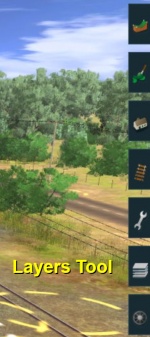 |
 |
Left Click the Layers Tool (or press F6 ) to open up its properties.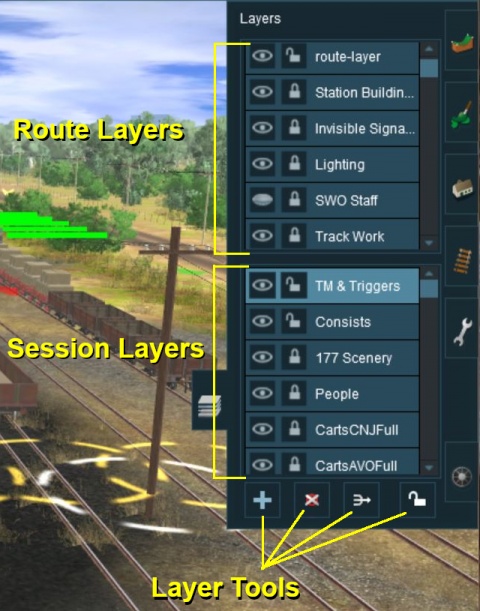 |
|
Loading a Route and Loading a Session (S10)
| In Summary: | |
| Route Layers are saved with the Route. Session Layers are saved with the Session. | |
| If you edit a Session Layer and later load just the Route then those edits will not appear. | |
 |
More information on creating, loading and saving Routes and Sessions can be found on the Trainz Wiki Page at Route and Session Basics |
The layers you see will depend on whether you have loaded a Route by itself (with no "child" Session) or a Session and its "parent" Route.
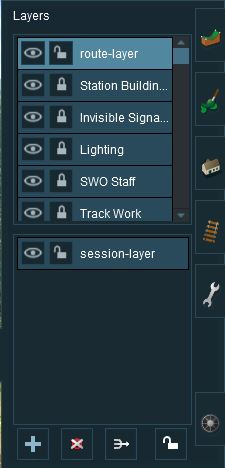 |
 |
The first image on the left gives an example of the layers that can appear if a Route only is loaded into Surveyor. These are the layers that are saved with the Route. Note that a default "session-layer" is present.
The second image on the left gives an example of the layers that can appear if a Session based on that Route is loaded into Surveyor. It shows Route Layers and Session Layers. In both cases, the Route Layers are identical because the same Route has been loaded. A Session contains its own layers, the Session Layers, that are loaded and saved with the Session but are not loaded or saved with the Route.
|
|
Creating a New Route (S10)
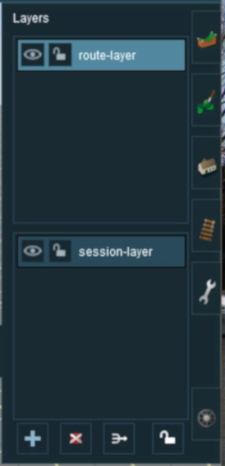 |
|
|||||||||
The "Active Layer" (S10)
| In Summary: | |
| The Active Layer is the selected (highlighted) layer. | |
| When you load the Route only into Surveyor, the first Route layer will be the Active Layer | |
| When you load a Session into Surveyor, the first Session layer will be the Active Layer | |
In the image above, the route-layer is the Active Layer. You can change the Active Layer at any time by a Left Click on the name of another layer.
|
|
Adding a New Layer (S10)
| Left Click the Add Button |
An Add layer dialogue window will appear.
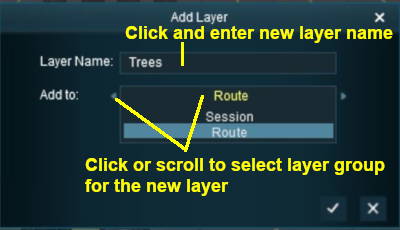 |
|
|||||||||
Deleting a Layer (S10)
|
| Select the layer to be deleted and Left Click on the Delete Button. If you don't select a layer to delete then Trainz will select the current Active Layer. |
|
If the layer being deleted is empty, then the following dialogue window will appear:-
 |
|
||||||
If the layer being deleted is NOT empty, then the following dialogue window will appear:-
 |
|
||||
|
|
|||||
Merging Layers (S10)
|
| Select the layer to be merged into another layer and Left Click the Merge button. If you don't select a layer to merge then Trainz will select the current Active Layer. |
| In Summary: | |
| Merging a layer into another layer will move ALL the objects from the first layer into the second layer. The first layer, which is now empty, will then be deleted. | |
| Once layers have been merged they cannot be separated. | |
|
The layer merge dialogue window will appear as shown below:-
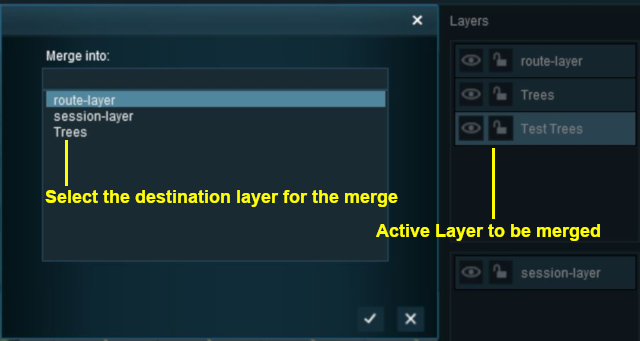 |
|
||||||
Locking Layers (S10)
|
| If you LOCK or UNLOCK a Route Layer while editing a Session then you will have made a change to the Route and will be asked to save both the Route and the Session when you exit Surveyor. |
Locking Individual Layers (S10)
To LOCK an individual layer, Left Click on the ![]() Open Padlock icon next to its name. The layer being locked does not have to be the current Active Layer.
Open Padlock icon next to its name. The layer being locked does not have to be the current Active Layer.
| The objects in a LOCKED layer cannot be moved (around the layout) or deleted but they can be moved to other layers. |
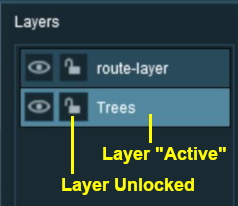 |
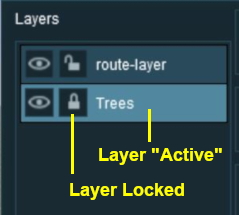 |
|
If you attempt to add a scenery object to a locked layer you will receive the following message:-

|
Locking ALL Route Layers (S10)
| Left Click on the Lock Button |
This will LOCK ALL the layers in the Route Layers Group. The Session Layers Group will not be affected.
The Route Layers Group can be UNLOCKED by a Left Click on the Lock Button again.
Moving a Layer (S10)
| Main Points: | |
Layers can be moved up or down
|
|
| A layer containing track objects (e.g. signals, switches, etc) CANNOT be placed above the layer containing the track | |
|
In the example shown below a layer created in the Route Layers Group is being moved into the Session Layers Group.
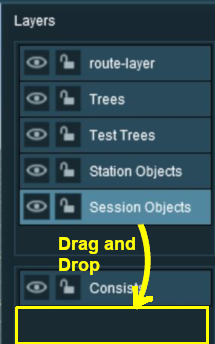 |
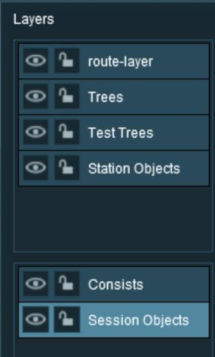 |
|
||||||||||
Hiding Layers (S10)
To hide or show a layer Left Click the Eye Icon next to its name.
 |
|
||||
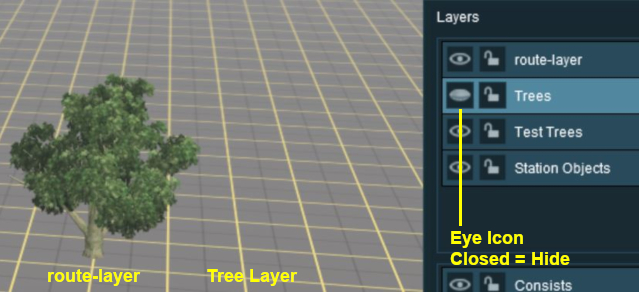 |
|
Adding Objects To Layers (S10)
When an object (such as a scenery item, consist, track or track object) is added to the layout it is automatically placed in the currently Active Layer. Unfortunately, Surveyor Classic (S10) does not indicate which layer is the Active Layer unless you open the Layers Tool to look. This can lead to objects being placed into the wrong layers and while these objects can later be moved to another layer (see the section Moving Objects To Other Layers below) it would be better to correctly set the Active Layer first.
|
| You cannot add objects to a layer that is LOCKED. |
If you attempt to add a scenery object to a locked layer you will receive the following message:-

|
| When adding track objects (signals, speed signs, etc) to a track, the objects being added must be in the same layer as the track or in a layer below the track layer. For more information, see the section |
|
Deleting Objects From Layers (S10)
|
| You cannot delete objects from a layer that is LOCKED. |
Unfortunately Trainz does not give you a warning message when you attempt to delete an object from a locked layer, the object just refuses to be deleted.
|
Moving Objects To Other Layers (S10)
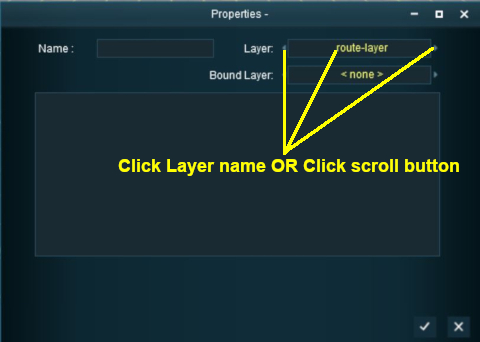
|
|
||||||||||
The Layers Palette in Surveyor 2.0 (S20)
Surveyor 2.0 is currently only available for Trainz Plus Standard and Trainz Plus Gold subscription members.
Layers are found in the Layers Palette.
|
|
|||||||||||||||||||||
Open a Layer Group (S20)
To the left of each Layer Group name is a small arrow. Left Click on the arrow to open up the group.
 |
The image on the left shows that the Session Layers Group is open and its individual layers are now displayed. To close or minimise the group Left Click on the arrow again. The image shows that the Session Layers Group contains 3 individual layers:-
|
Add a New Layer (S20)
You cannot create new layer groups but you can add new layers to a existing group.
Each Layer Group has a ![]() icon next to its name. Left ClickLeft Click on the icon to add and name a new layer to that group. If you are adding a new Effect Layer then you will also have to identify the type of effect - TurfFX, Clutter or Water.
icon next to its name. Left ClickLeft Click on the icon to add and name a new layer to that group. If you are adding a new Effect Layer then you will also have to identify the type of effect - TurfFX, Clutter or Water.
Renaming a Layer (S20)
 |
Right Click on a layer name and select Rename Layer.. from the popup menu. You will be asked to enter a new name for the layer. |
Deleting a Layer (S20)
 |
Right Click on a layer name and select Delete Layer from the popup menu. You will be given a warning that you are about to delete a layer.
|
Moving a Layer (S20)
Layers can be individually moved up and down within the same layer group or between the Route Layers Group and the Session Layers Group.
|
Left Click on a layer name and, while holding the left button down, drag the layer up or down to its new position.
- depending on the contents of the layer, the process may take some time. You will be shown a progress bar during the move operation
- the move can be reversed (after it has completed) by using the Ctrl Z keys
Merging a Layer (S20)
 |
Right Click on a layer name and select Merge Layer Up from the popup menu.
|
Hiding Layers (S20)
Each individual layer has an Eye icon that controls the visible state of that layer. Left Click on the icon to toggle its state between visible and hidden.
If the Eye is:-
 open then layer is visible in both Surveyor and Driver
open then layer is visible in both Surveyor and Driver
 closed then layer is hidden in both Surveyor and Driver
closed then layer is hidden in both Surveyor and Driver
Locking Layers (S20)
Each individual layer has a Padlock icon that controls the state (![]() Locked or
Locked or ![]() Unlocked) of that layer. Left Click on the icon to toggle its state between Locked and Unlocked.
Unlocked) of that layer. Left Click on the icon to toggle its state between Locked and Unlocked.
If the Padlock is:-
 open then the layer is Unlocked and can be edited
open then the layer is Unlocked and can be edited
 closed then the layer is Locked and cannot be edited
closed then the layer is Locked and cannot be edited
|
Setting the Active Layer (S20)
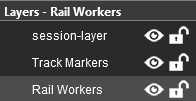 |
the Active Layer is the layer where new objects will be automatically added when using the Placement Tool. The active layer is shown in the palette with its name on a blue background. In the image on the left the Rail Workers layer is the current Active Layer. The name of the current Active Layer is also shown in the Layer Palette Title Bar. To set a new Active Layer, Double Left Click on a layer name. |
Move an Object to a New Layer (S20)
| The Info Palette will show the layer assigned to the currently selected object. An object is selected by using the Free Move Tool (the S key) or the Fine Adjustment Tool (the D key) found in the Tools Palette.
|
||
|
|
|
|
Route Layers vs Session Layers
This topic has filled endless threads in the Trainz Forums with arguments raging on both sides.
| In Summary: | |
| In general, there are no "cast iron" rules that dictate what should be placed in the Route Layers Group and what should be placed in the Session Layers Group (for an exception see TRS19 Platinum Edition, Trainz Plus, TRS22 Notes below). Each Route and Session will be different and different creators have different ways of working. The main question to be asked is how many different Sessions will be created using a particular Route? | |
Notes:
|
TRS19 Platinum Edition, Trainz Plus, TRS22 Notes:
|
The Route Layers Group
| The Route Layer Group should be used for everything that will always appear in Driver Mode regardless of which Session is playing. |
There is nothing stopping you from placing everything in the "route-layer" of the Route Layers Group and never having to worry about dealing with layers ever again - some creators prefer to work this way. However, layers do provide you with a way of organising your scenery objects to make them more manageable, particularly in more complicated layouts. Some examples:-
|
|
The "route-layer"
| To avoid any confusion over which layer is the original "route-layer", this is one layer that should not be renamed or moved from the top position. |
While all layers are equal, the "route-layer" is special.
|
|
The Session Layers Group
| The Session Layers Group should be used for everything that will only be seen in the currently loaded Session. |
If you are creating more than one Session based around a particular Route, then you will probably make use of the Session Layers.
| Notes: Session Layers can contain:-
|
||||
|
||||
The "session-layer"
An empty session-layer will be automatically created when you:-
- load a route without also loading a session, or
- create a new route
If you add anything to the session-layer or add new layers to the Session Layers Group and do not save the session before you exit from Trainz then these changes will be lost.
The Bound Layer
| In Trainz Plus and TRS22 the Bound Layer is often referred to as the Binding Layer |
This is a little used and probably little understood layer feature. It allows you to attach an object to two different layers so it can have the properties (locked/unlocked and show/hide) of both layers. The bound/binding layer was introduced as a development tool, its sole use is as a tool in the building of routes and sessions.
| An object will be LOCKED and cannot be deleted or moved if its layer OR its bound/binding layer is locked. | |
| An object will be HIDDEN if its layer OR its bound/binding layer is hidden. | |
| Rulers cannot be bound to another layer. |
|
|
||||||||||||||||||||||||||||||||||||||||
|
|
|
Setting the Bound Layer in Surveyor Classic (S10)
 |
|
||||||
| When a layer is deleted any objects bound to that layer will have their Bound Layer reset to <none> |
Setting the Bound Layer in Surveyor 2.0 (S20)
Surveyor 2.0 is currently only available for Trainz Plus Standard and Trainz Plus Gold subscription members.
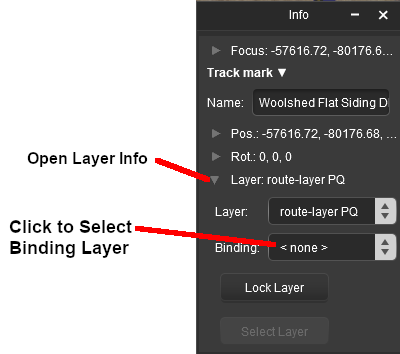 |
|
||||||
| When a layer is deleted any objects bound to that layer will have their Bound Layer reset to <none> |
Layers in Driver Mode
During the running of a Session in Driver Mode visible layers can be hidden and invisible layers revealled according to the events that occur during the Session.
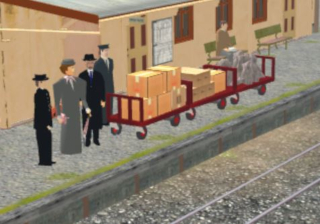 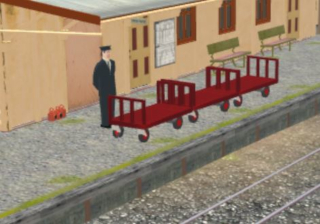 |
The two Driver Mode scenes shown on the left illustrate this feature.
|
This effect could be achieved in two different ways:-
- A Driver Command - specific to a particular driver, or
- A Session Rule - specific to a particular driver, consist, or any driver/consist
Using a Driver Command
The driver command Layer Control hides and shows named layers.
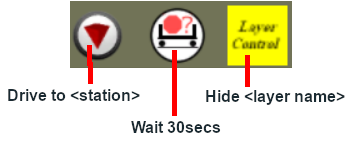
Using Session Rules
 |
Rules Used: |
- Trackside Check Rule - to trigger the event
- Show/Hide Layer Rule - to hide layers
- Message Popup Rule - to open a browser window with a message
 |
Session Editor Screenshot: |
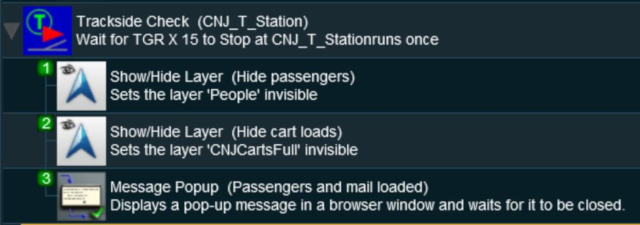 |
 |
Description: |
In this example:-
- The Trackside Check Rule is triggered when a specific train comes to a stop at a trackmark. This then executes the following rules in order:-
- The Show/Hide Layer Rule is used to hide the layer named "People". Four passengers (three standing and one seated) are hidden.
- The Show/Hide Layer Rule is used to hide the layer named "CNJCartsFull". The boxes and mail bags on the three platform trolleys are hidden.
- The Message Popup Rule is used to place a message on the screen informing the player that the passengers and mail have been loaded.
Trainz Wiki
 |
More Tutorials and Guides to Using Trainz |
This page was created by Trainz user pware in June 2018 and was last updated as shown below.

